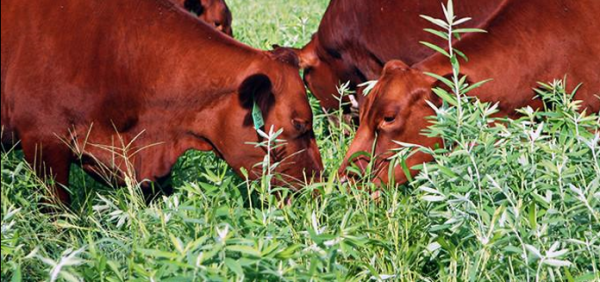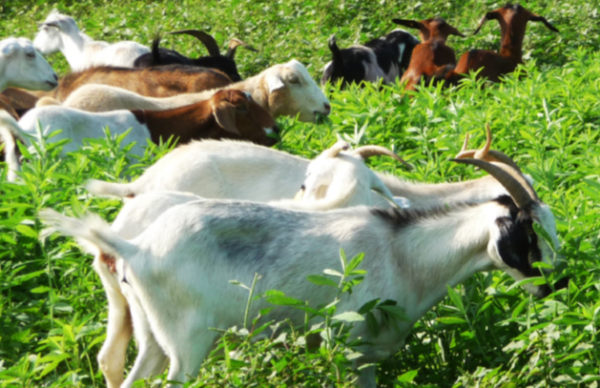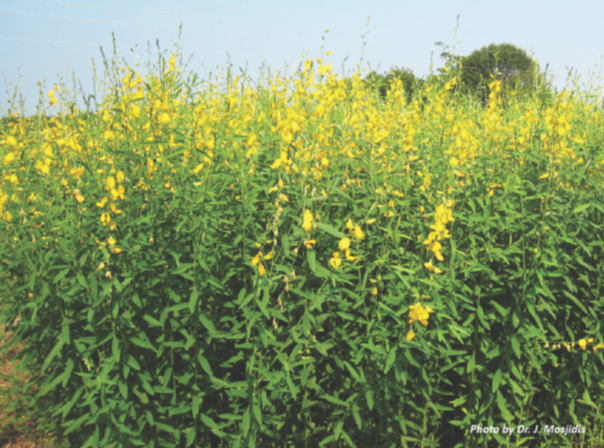Forages

Sunn hemp (Crotalaria juncea L.) is a warm-season, annual legume that grows up to six feet tall. Until recently, the use of sunn hemp has been limited by the availability of seed. However, newer varieties (i.e. AU Golden and AU Darbin) have been bred that have the capability to produce seed in temperate climates. Sunn hemp is drought tolerant and tolerates moderately low soil pH, growing in soils with a pH between 5.0 and 8.4. It also tolerates low soil fertility, however, its productivity is enhanced in fertile soils.
Establishment
Sunn hemp is an annual, and therefore must be planted every year. Once the soil temperature has reached 65°F, sunn hemp can be planted into a prepared seedbed. Plant at 25 to 30 pounds pure, live seed per acre and inoculate with a cowpea type inoculant. Seeding depth is ¼ inch to one inch. Due to its wide tolerance of soil pH, liming is not necessary, but is recommended. Nitrogen fertilizer is not required as sunn hemp is a legume, but phosphorus and potash should be added based on soil test results.
Sunn hemp grows best in sandy, well-drained soils. It is not tolerant of standing water or heavy, clay soils. During the first 30 days after planting, the plant will have little above ground biomass production. However, by day 60, plants can be six feet tall. In order to maximize the length of the grazing season, plantings of sunn hemp can be staggered (May and July). This allows for a higher quality forage throughout the grazing season and into early fall.

Grazing Management

Photo Courtesy of Dr. J. Burke
Sunn hemp can be grazed by cattle, goats, and sheep. Start grazing when plants are one and a half to three feet tall, approximately 45 days after planting. The leaves are of high quality (see Table 1), but the stems are of much lower quality (8-10% crude protein, 75% neutral detergent fiber, 65% acid detergent fiber). However, the stems provide the fiber needed for proper rumen function. In order to maintain forage quality, maximizing the leaf-to-stem ratio is important. A field allowed to grow until flowering may lose lower leaves, and have reduced forage quality due to a lower leaf-to-stem ratio. When the field as at 80% bloom, only 35to 40% of the field biomass is leaves.
To ensure forage quality, early grazing is important. Rotate livestock out of the field once the forage has reached 12 to 18 inches. Due to its high quality, sunn hemp is well suited for limit grazing (one to three hours per day) in combination with warm-season perennial pastures. At first, livestock may not find sunn hemp palatable, but within one to three days they will develop a taste for it. If sunn hemp is grazed too early, livestock will over-graze, possibly killing it. If plants are grazed too high (six feet), the livestock will break the plants and will not regrow. Mowing or grazing sunn hemp to less than 12 inches can also prevent plant regrowth. It is not suggested to cut sunn hemp for hay or silage.
Table 1. Forage Yield and Quality of Sunn Hemp Grown in Alabama
| Yield | Estimated Nitrogen Fixation | Crude Protein (leaf) | Neutral Detergent Fiber (leaf) | Acid Detergent Fiber (leaf) |
|---|---|---|---|---|
| 3,000 – 10,000 lb DM/acre | 120 lbs/acre/year | 25-30% | 22-28% | 22-27% |
Possible Toxicity Concerns
Seeds
Sunn hemp is in the genus Crotalaria, which is characterized by presence of pyrrolizidine alkaloids in the seeds. However of the hundreds of compounds in this family, sunn hemp contains only low levels of two to three different alkaloids. Non-ruminants (swine, chickens, and horses) are more susceptible to acute toxicity from ingesting seeds compared to ruminants (cattle, sheep, and goats). It is not suggested to incorporate sunn hemp seed into livestock diets due to weight loss concerns. However, the consumption of a small amount of seed while grazing will not cause an acute toxicity in livestock.
Forage
Neither leaves nor stems of sunn hemp have been found to be toxic to any class of livestock, and do not contain any pyrrolizidine alkaloids. Therefore, there is no concern of toxicity when grazing forage.
Featured Image: Couresy of Dr. J. Mosjidis

